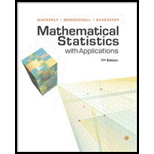
Concept explainers
In Exercise 5.12, we were given the following joint
- a Find P(Y1 ≤ 1/2|Y2 ≤ 1/4).
- b Find P(Y1 ≤ 1/2|Y2 ≤ 1/4).
5.12 Let Y1 and Y2 denote the proportions of two different types of components in a sample from a mixture of chemicals used as an insecticide. Suppose that Y1 and Y2 have the joint density function given by
(Notice that Y1 + Y2 ≤ 1 because the random variables denote proportions within the same sample.) Find
- c P(Y1 ≤ 3/4, Y2 ≤ 3/4).
- d P(Y1 ≤ 1/2, Y2 ≤ 1/2).
Want to see the full answer?
Check out a sample textbook solution
Chapter 5 Solutions
Mathematical Statistics with Applications
- Show all workarrow_forwardplease find the answers for the yellows boxes using the information and the picture belowarrow_forwardA marketing agency wants to determine whether different advertising platforms generate significantly different levels of customer engagement. The agency measures the average number of daily clicks on ads for three platforms: Social Media, Search Engines, and Email Campaigns. The agency collects data on daily clicks for each platform over a 10-day period and wants to test whether there is a statistically significant difference in the mean number of daily clicks among these platforms. Conduct ANOVA test. You can provide your answer by inserting a text box and the answer must include: also please provide a step by on getting the answers in excel Null hypothesis, Alternative hypothesis, Show answer (output table/summary table), and Conclusion based on the P value.arrow_forward
- A company found that the daily sales revenue of its flagship product follows a normal distribution with a mean of $4500 and a standard deviation of $450. The company defines a "high-sales day" that is, any day with sales exceeding $4800. please provide a step by step on how to get the answers Q: What percentage of days can the company expect to have "high-sales days" or sales greater than $4800? Q: What is the sales revenue threshold for the bottom 10% of days? (please note that 10% refers to the probability/area under bell curve towards the lower tail of bell curve) Provide answers in the yellow cellsarrow_forwardBusiness Discussarrow_forwardThe following data represent total ventilation measured in liters of air per minute per square meter of body area for two independent (and randomly chosen) samples. Analyze these data using the appropriate non-parametric hypothesis testarrow_forward
 Glencoe Algebra 1, Student Edition, 9780079039897...AlgebraISBN:9780079039897Author:CarterPublisher:McGraw Hill
Glencoe Algebra 1, Student Edition, 9780079039897...AlgebraISBN:9780079039897Author:CarterPublisher:McGraw Hill
